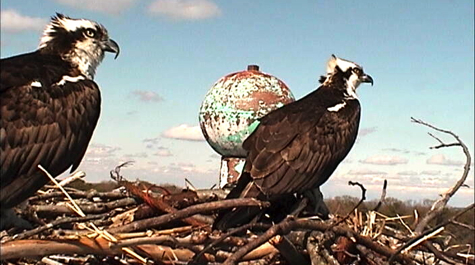About Ospreys
Ospreys (Pandion haliaetus) are of particular interest to researchers at the Virginia Institute of Marine Science because they are the only birds of prey that subsist almost exclusively on a diet of live fish—hence their common name of "fish hawks."
Range & Migration
Ospreys are such a common sight above Chesapeake Bay during the summer months that it’s easy to forget that our “local” birds spend almost half their year in and around the coastal and inland waters of South America. Indeed, ospreys are one of the most wide-ranging birds in the world, with populations on all continents except Antarctica, and on many oceanic islands. The one constant of their distribution is proximity to water.
Ospreys are common warm-weather residents of Chesapeake Bay and other East Coast estuaries as far north as the Canadian Maritime provinces. Local birds arrive in Chesapeake Bay in early March and remain into October, when they begin to migrate south for the winter. Most spend the colder months in South America, ranging from Venezuela to as far south as Paraguay and even Argentina.
During their fall migration, East Coast ospreys move southward in a broad band that stretches from the coast several hundred miles inland. This flyway narrows to the tip of Florida, then continues to Cuba and Hispaniola. Some osprey remain in the Caribbean, but most make a beeline across 500 miles of open water to Venezuela before fanning out further south into the Amazon Basin and the Pantanal, the world's largest freshwater wetland.
Young-of-the-year osprey (those hatched and fledged during the current summer) typically begin their southward migration several weeks later than older juveniles and adults, presumably to further hone their recently learned fishing skills and increase their energy stores. Remarkably, instinct alone then guides them all the way to South America, a journey of from 2,500 (Venezuela) to 5,000 miles (the Pantanal). These young-of-the-year birds then typically spend an entire year and a half in South America before making their return migration.
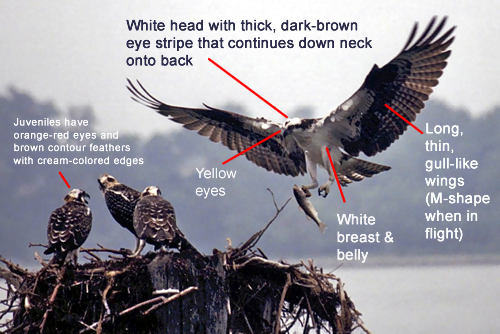
Ospreys conserve energy during their lengthy spring and fall migrations by alternately using rising air currents (thermals) to soar to great heights, then gliding forward and downward before catching the next thermal. Tagging studies show that they can travel up to 500 miles in a single day, although they typically average around 100 miles.
Diet
A 1985 study by researchers in the Department of Biology at the College of William and Mary showed that Atlantic menhaden (Brevortia tyrannus) is the major food source for ospreys in lower Chesapeake Bay, accounting for nearly 75% of the birds’ diet. White perch (Morone americana), Atlantic croaker (Micropogonias undulatus), oyster toadfish (Opsanus tau), and American eel (Anguilla rostrata) are also common prey.
The study found that the birds delivered 5.4 fish per day on average to the nest, with the average fish weighing just over a third of a pound. The length of the fish captured by the ospreys ranged from 4 to 43 centimeters (1.5 to 16 inches).
A 2009 study by researchers with W&M's Center for Conservation Biology (CCB) refined the results of the earlier study, showing that the diet of ospreys in Chesapeake Bay varies by salinity, with Atlantic menhaden and seatrouts (Cynoscion spp.) the most common prey item for breeding pairs within the saltier waters of the lower Bay, whereas gizzard shad (Dorosoma cepedianum) and catfish (Ictaluridae) dominated in the fresher waters of tributaries.
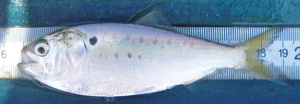 Their study also showed that fish from higher-salinity waters were on average 6% shorter, 34% lighter, and 40% lower in energy content than those from fresher waters upstream. They conclude that this difference in diet quality may help explain why osprey populations are recovering from their DDT-induced, 1970s decline more rapidly along the Bay's tributaries than they are in the saltier waters of the Bay's mainstem. A 2004 study by CCB researchers revealed that the mean doubling times of osprey populations ranged from 4.3 yr along the lower-salinity reaches of upper tributaries to more than 40 years in higher-salinity areas of the Bay proper.
Their study also showed that fish from higher-salinity waters were on average 6% shorter, 34% lighter, and 40% lower in energy content than those from fresher waters upstream. They conclude that this difference in diet quality may help explain why osprey populations are recovering from their DDT-induced, 1970s decline more rapidly along the Bay's tributaries than they are in the saltier waters of the Bay's mainstem. A 2004 study by CCB researchers revealed that the mean doubling times of osprey populations ranged from 4.3 yr along the lower-salinity reaches of upper tributaries to more than 40 years in higher-salinity areas of the Bay proper.
Based on an estimated Chesapeake Bay population of 3,000 breeding pairs (in 1985), the authors of the 1985 study estimated that ospreys eat about 132,171 kg (291,387 pounds) of fish during the 52-day nestling period. They note that this "harvest" represents 0.004% of the annual Chesapeake Bay commercial harvest and likely has a minimal impact on local fisheries.
Name
Ospreys have a variety of common names, including fish hawks, sea hawks, and eagle hawks. Their Spanish name (gavilán pescador or “fishing hawk”) and French name (balbusard pêcheur or “bald buzzard fisherman”) also make reference to their prowess as aerial anglers.
The osprey’s scientific name, Pandion haliaetus, comes from a mythical king of Athens, Pandion, whose daughters were turned into birds, and the Greek words halos (sea) and aetos (eagle).
The common English name is from the Old French "ospreit", which derives from the Latin "avis praedae" meaning "bird of prey." “Avis praedea” is a generic term for any raptor, and apparently became associated with ospreys in Old French based on the similarity of its sound to ossifrage (Latin "bone-breaker”), a very large Old World vulture that swallows and digests bones.
Breeding Habits
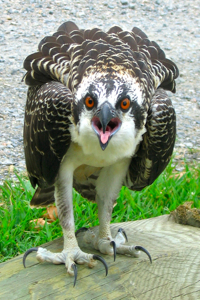
The following material is adapted with permission from a fact sheet produced by the Hawk Mountain Sanctuary in eastern Pennsylvania.
Historically, Chesapeake Bay has supported the largest concentration of breeding ospreys in the world.
Ospreys are usually monogamous. Pairs repeatedly return to the same nest site, and often remain together for many years, sometimes for life. Older individuals, and in particular pairs that have bred together previously, tend to be more successful than newly formed pairs. Ospreys typically breed for the first time when they are 3 or 4 years old.
Males return to the breeding grounds before females and select the nest site. Some males perform aerial displays even before females arrive. The displays, which peak after the female arrives, allow the male to mark his territory and to solicit the attention of a female. So called sky dances usually begin and end at the nest site, and while performing the display, males usually carry a fish or nesting material and call repeatedly. Sky dances incorporate undulating flights, which sometimes reach heights of 300 feet or more. At the top of each undulation, males typically hover briefly with their legs dangling and their tails fanned, and then dive downward with their wings drawn in. They may repeat this sequence several times. During courtship, males also provide food for their mates, follow them closely, and chase away other males.
Nesting
Ospreys prefer to build their large stick nests near water at sites with good visibility and limited access for predators. Typical nest sites include dead or relatively open live trees in or within a few kilometers of open water. Cliffs, rocky outcrops, and even cacti are sometimes used. On rare occasions, ospreys nest on the ground. They also nest on utility poles, duck blinds, channel markers, and nesting platforms erected specifically for them. Nests usually are renovated and reused annually either until the base collapses or until the nest is damaged in a storm.
Nests often are 5 feet across and 2-3 feet deep when they are first built and increase in size each year thereafter. Smaller birds, including House Sparrows and Monk Parakeets, sometimes nest within an osprey’s nest. Osprey pairs can construct their nests in as few as 7 to 10 days. Males gather most of the material for the main structure and females collect most of the material for the nest lining. Although pairs defend the immediate area around the nest, ospreys sometimes nest in loose colonies in areas where prey is abundant.
A 2004 study by researchers with W&M's Center for Conservation Biology (CCB) studied nesting patterns among Chesapeake Bay ospreys and compared their finding with a nesting study done in 1973. They found that use of trees for nesting had declined from 31.7% to 7.2% during that 23-year period. Channel markers accounted for 53.5% of all nest structures in the 2004 study, whereas platforms established specifically for ospreys supported 12.1% of pairs. The authors conclude that the proliferation and diversification of man-made nest sites throughout Chesapeake Bay has been one of the most important factors contributing to recent expansion of the Bay's osprey population.
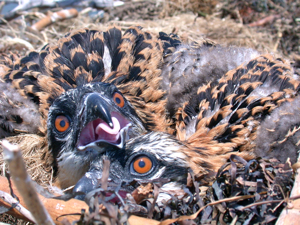 The Clutch
The Clutch
Ospreys typically lay 2- or 3- egg clutches. Incubation begins when the first egg is laid and clutches hatch asynchronously. When food is limiting, younger chicks that are unable to compete with their larger, older siblings often starve. Females do most of the incubating during the 34 to 40 day incubation period. After the eggs hatch, the female broods the nestlings continually for 10 days. Throughout this period, the male provides food for the female.
Nestlings are able to feed themselves when they are about six weeks old, at which time females begin to hunt for themselves and their young. The young leave the nest when they are 7 to 8 weeks old, and will continue to roost at and around the nest for another month. During the day, fledglings perch near the nest and will sometimes fly after the male begging for food while he hunts. Young usually catch their first fish 2 to 8 weeks after fledging.
Feeding Habits
The following material is adapted with permission from a fact sheet produced by the Hawk Mountain Sanctuary in eastern Pennsylvania.
Although there are anecdotal reports of osprey catching mollusks, snakes, birds, and mammals, fish comprise more than 99% of the species’ diet. Unlike bald eagles, ospreys usually do not feed on carrion.
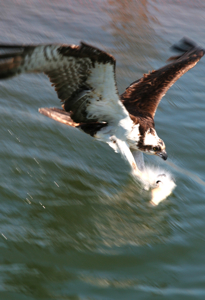 Most ospreys are opportunistic and feed on the most accessible, abundant, and appropriately sized fish available. The species is not designed for deep diving and most fish are caught at or near the surface. Ospreys usually search for their prey from the air. Doing so is more energetically costly than perch-hunting, but it enables ospreys to search for food across greater areas. Perch-hunting is more common in winter when individuals only need to feed themselves.
Most ospreys are opportunistic and feed on the most accessible, abundant, and appropriately sized fish available. The species is not designed for deep diving and most fish are caught at or near the surface. Ospreys usually search for their prey from the air. Doing so is more energetically costly than perch-hunting, but it enables ospreys to search for food across greater areas. Perch-hunting is more common in winter when individuals only need to feed themselves.
While hunting, ospreys fly slowly over the water and often hover briefly when scanning intently. When an osprey detects a fish, it tucks its wings and drops toward the water. While descending, the osprey uses its wings and tail to adjust its position. Ospreys plunge into the water feet-first with their legs and talons fully extended. After diving, ospreys rest for a moment on the water and secure their grip on their prey before taking off. Once airborne with a fish, ospreys place one foot in front of the other, and rearrange the fish so the head faces forward. A flexible outer toe allows them to carry fish with two talons securely placed on either side of their prey.
Hunting success depends on the age of the osprey, type of fish, and weather. Young ospreys are less proficient hunters than adults. Ospreys typically catch slow- moving, bottom-dwelling species and are least adept at capturing fast-moving fish. Hunting becomes more difficult in choppy and murky water. The presence of emergent and submerged vegetation also decreases hunting success.
Conservation Status
The following material is adaptedwith permission from a fact sheet produced by the Hawk Mountain Sanctuary in eastern Pennsylvania.
The current world population of ospreys is estimated at fewer than 100,000 birds. In 2001, the number of breeding pairs in the lower 48 United States was estimated at between 16,000 and 19,000.
In the 1950s and 1960s, osprey populations decreased and the species was extirpated from many areas due to the effects of organochlorine pesticides like DDT. When ospreys consume fish containing pesticides such as DDT, these chemicals accumulate in their fatty tissues. DDT and other organochlorine pesticides compromise reproductive success by causing eggshell thinning. Osprey populations have increased in the United States since the late 1970s. Numbers increased primarily due to a ban on the widespread use of DDT in 1972.
Today, osprey numbers in the United States are increasing and individuals are returning to formerly vacated breeding grounds, as well as expanding into new areas. Restoration efforts involving reintroduction programs, as well as the provision of artificial nest sites, aided in the osprey’s recovery. Artificial nest platforms provide increased numbers of available nest sites and offer sturdy, safe nesting locations. Today, many osprey populations nest almost entirely on artificial nest sites.
Ospreys continue to be shot in some parts of their range, particularly at fish farms in Latin America and South America. Although ospreys tolerate human activity, excessive disturbance can disrupt nesting. Collisions with vehicles and power-lines also are sources of mortalities. Electrocution is another threat to ospreys around power-lines. Environmental contaminants continue to be a potential source of fatalities as well.



